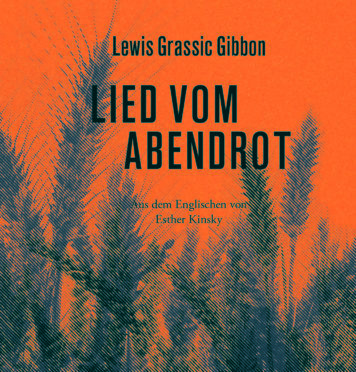Sunset Song, Lewis Grassic Gibbon׳s classic Mearns masterpiece and Scotland’s favourite book, has been published in German for the first time since the fall of the Berlin Wall.
Under the German title ‘Lied vom Abendrot׳, Grassic Gibbon’s book, which tells the story of the dysfunctional Guthrie family on the fictional north-east estate of Kinraddie, has been published by Guggolz Verlag in Berlin, whose owner Sebastian Guggolz said that the book is doing well both in terms of sales and reviews.
Foreign literature forms a big part of the German book market – browse any bookshop in Berlin, Munich or Hamburg and you will inevitably come across a number of books written by Scots.
It is therefore surprising that a literary heavyweight like Lewis Grassic Gibbon seems to have been overlooked.
However, it is a little-known fact that back in the 1970s a publishing house in East Berlin undertook the daunting task of producing a translation of Grassic Gibbon’s entire trilogy A Scots Quair.
Between 1970 and 1986 three editions were published in the GDR, or East Germany, but after the fall of the Berlin Wall the books were never re-printed.
Several decades later Grassic Gibbon׳s books were well and truly forgotten.
Luckily there are still publishers with a feel for hidden treasures and the willingness to invest in lesser known authors.
Mr Guggolz became aware of ‘Scotland׳s Favourite Book׳ – as decided by a BBC poll in 2016 – through German author and literary translator Esther Kinsky who, in turn, had come across Grassic Gibbon through her own Scottish family connections.
Mr Guggolz quickly realised the potential of Grassic Gibbon and was convinced that one of the north-east’s favourite sons deserved to be re-introduced to a German-speaking audience.
His first project was a translation of a selection of Grassic Gibbon׳s stories and essays in Scottish Scene, published jointly with Hugh MacDiarmid in 1934.
The small volume, translated by Esther Kinsky and published in autumn 2016 as ‘Szenen aus Schottland׳ (Scenes from Scotland), was reviewed very favourably and sold well according to Mr Guggolz.
Encouraged by this initial success, both publisher and translator decided to take on Sunset Song.
In the process Esther Kinsky spent time in the Stonehaven area to get a feel for the land and the speak of the Mearns.
Regina Erich, a German translator based in Stonehaven, said: “The result is a brilliant, authentic translation.
“It doesn’t only do justice to the original but also conveys the nature of the landscape, the characters and the general flavour of the story.
“It also puts north-east Scotland and the Mearns firmly on the map of an international readership.״
So far reviews are glowing with praise.
The German daily paper Frankfurter Allgemeine Zeitung, for example, notes “Esther Kinsky has translated the story into such a unique and powerful-sounding, resonating German that you don’t want to put the book down.
“Each paragraph is a delight. ״
There is every chance that German-speaking readers will grow as fond of Lewis Grassic Gibbon׳s masterpiece as Scots are of their favourite novel.










